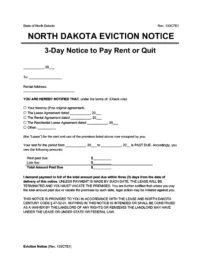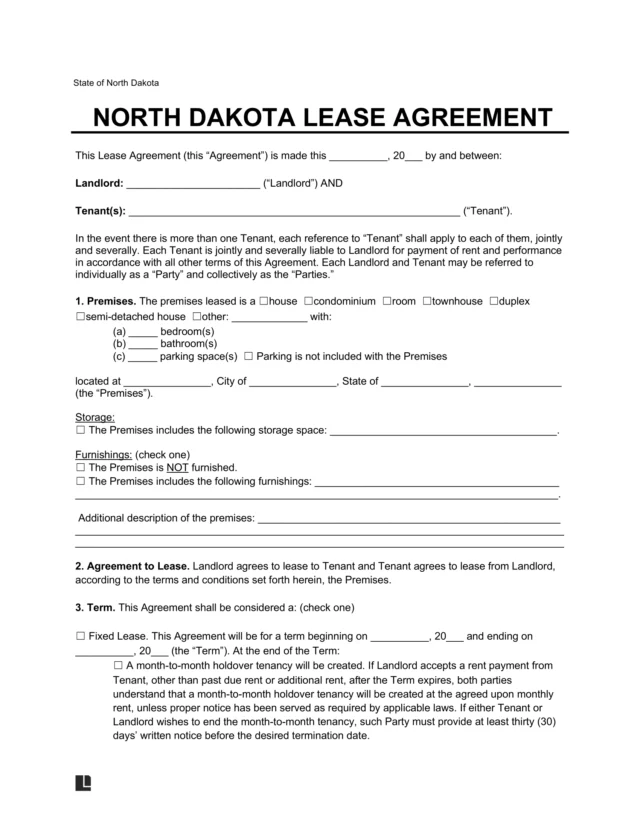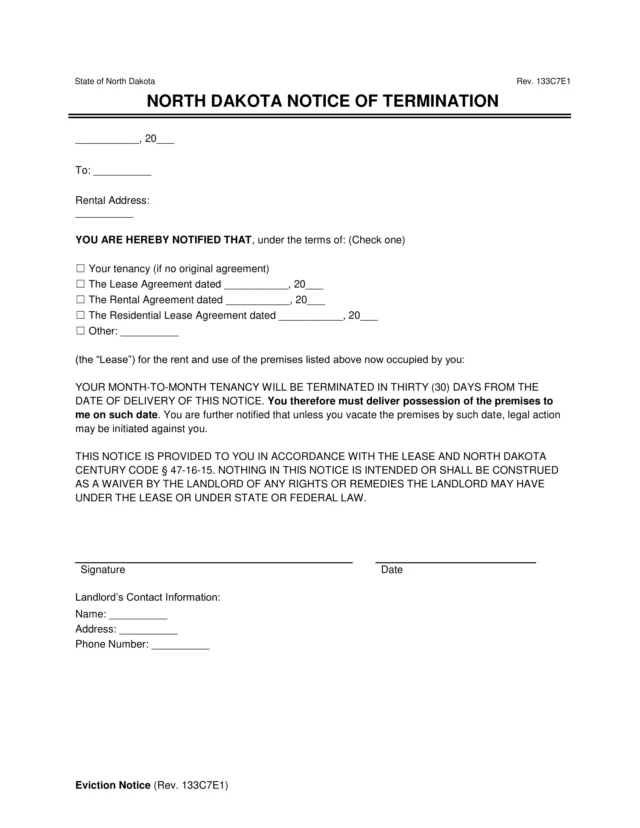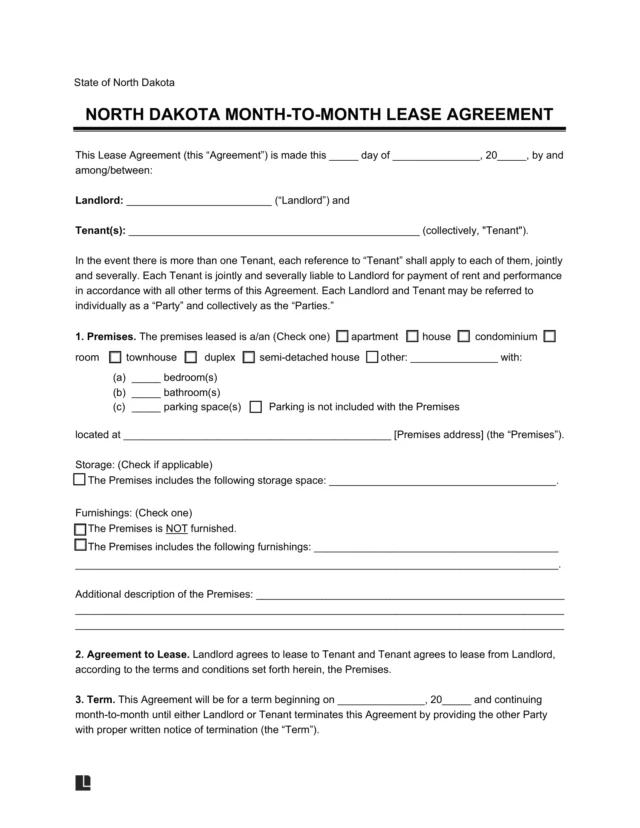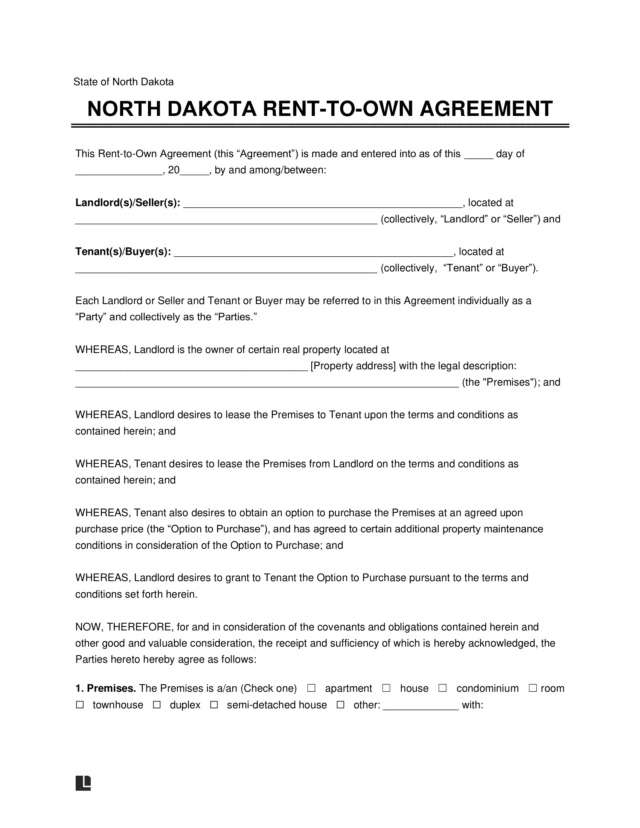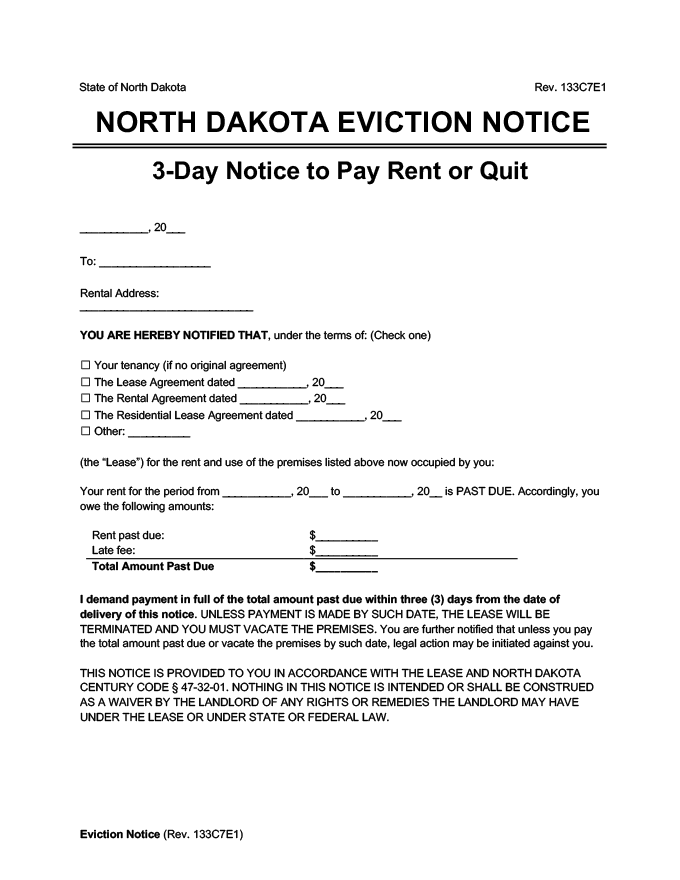Understanding Eviction Notices in North Dakota
To legally evict a tenant in North Dakota, landlords must begin with a written notice that fits the reason. Whether the tenant failed to pay rent or broke a lease rule, we have a template that works for your situation.
Our document editor helps you create the appropriate North Dakota eviction notice easily. Save and download it in PDF or Word format.
Types of Eviction Notices in North Dakota
North Dakota law sets specific timelines for eviction notices depending on whether the termination involves unpaid rent, illegal activity, or other breaches.
3-Day Notice to Pay Rent or Quit
Issue this form to tenants who fail to pay rent, giving them three days to settle the dues or vacate the property under § 47-32-01. If the tenant does not rectify the breach within three days, the landlord can initiate eviction proceedings, which can start between three and fifteen days after the notice period.
3-Day Notice to Pay Rent or Quit
In North Dakota, landlords must give tenants a three day notice period to pay rent before the eviction process can proceed in court.
3-Day Notice to Quit for Non-Compliance
If a tenant breaches their lease terms, you can issue this notice. It can help resolve unreported pets, unauthorized occupants, property damage, or illegal activity. Depending on the violation, you can have them fix the breach or move out within three days under § 47-32-01.
3-Day Notice to Quit for Non-Compliance
Begin evicting a tenant if they’ve broken the terms of your lease agreement.
30-Day Notice Lease Termination
If you want to end a month-to-month rental agreement, use a 30-day notice lease termination. In month-to-month contracts, as long as the required one-month notice is given under § 47-16-07, landlords are not obligated to explain the reason for termination.
30-Day Notice Lease Termination
Landlords must give tenants 30 days’ notice to move out if they’re on a month-to-month lease.
How to Evict a Tenant in North Dakota
Chapter 47-32 of the North Dakota Century Code governs the eviction process in North Dakota. Before filing an eviction lawsuit against your tenants, you must serve them a state law-compliant notice.
Step 1: Serve Notice
To begin the eviction process, you must first serve your tenant with the appropriate notice (via first-class mail, registered or certified mail, process server, or personal service).
Service of process in eviction cases is governed by Rule 4 of the North Dakota Rules of Civil Procedure.
The eviction notice must contain the tenant’s full name and sufficient information to inform the tenant of the lease term they’ve violated and how to avoid evicting.
Step 2: File and Serve Eviction Summons and Complaint
At this point, the tenant has three choices:
- Pay their late rent (if applicable)
- Fix (or “cure”) the violation (if applicable)
- move out of the property,
If the tenant doesn’t meet the demands stated in the notice within the given time period, the landlord can start the court eviction process.
The landlord files the Eviction Summons and Complaint with the district court in the county where the rental property is located and serves a copy of the Summons and Complaint on the tenant.
Step 3: Eviction Hearing
The court will schedule a hearing after the landlord files the Eviction Summons and Complaint and pays the filing fee. The Summons will notify the tenant of the hearing date, time, and location and that they must attend.
The case could be dismissed if the landlord fails to attend the hearing. The court could enter a default judgment in the landlord’s favor if the tenant fails to attend.
Step 4: Outcome
If the district court finds that the landlord has proven the right to repossess the property and collect damages, it will enter a judgment for possession.
A tenant’s failure to promptly vacate the property after this judgment has been entered can result in additional financial sanctions. This is particularly true if the landlord must return to court to seek a writ of possession or writ of execution.
Related Court Forms
- Instructions: Informational packet to help landlords understand what to do and expect during the eviction.
- Notice of Intention to Evict (Form 1a): This form demands payment of rent by a tenant, or else they must vacate the property.
- Notice of Intention to Evict (Form 1b): This form states that the tenant has violated the lease agreement and they must move out.
- Affidavit of Identification: This document sets forth the landlord’s identification information, the tenant’s identification information, and whether the tenant is in the military.
- Statement of Costs & Disbursements: This document allows the landlord to collect damages associated with the eviction action and those associated with the underlying eviction itself.
The summons and complaint forms below are court documents used when the notice goes unheeded and the landlord seeks a court order to remove the tenant.

